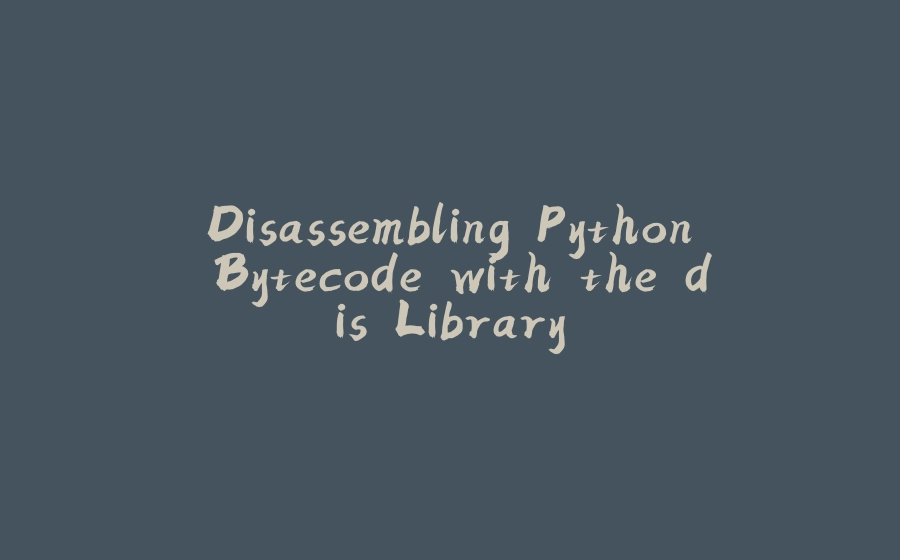Python Basics (37 Part Series)
1 Determining Python Version using the sys Library
2 Terminating a Python Program Using the Exit Function
… 33 more parts…
3 Python: A Guide to Variables
4 Python: Interacting with Users and Handling Sensitive Information
5 Python: Understanding Boolean Values and Operators
6 Introduction to the Python Math Library
7 Introduction to the Python Random Library
8 Working with Bytes in Python
9 Working with Tuples in Python
10 Working with Named Tuples in Python
11 Exploring Deques in Python
12 Python: A Guide to For and While Loops
13 Python: A Guide to Functions
14 Python: A Guide to Lambda Functions
15 Introduction to Classes in Python
16 Introduction to Python Modules and Libraries
17 Handling Exceptions in Python
18 Conditional Statements in Python
19 Disassembling Python Bytecode with the dis Library
20 Datetime Manipulation in Python
21 Using tomllib for Configuration in Python
22 Exploring the os Library With Python
23 Exploring API Requests in Python with the Official Joke API
24 Exploring Alice in Wonderland through Text Files in Python
25 Embracing the Zen of Python: A Guide to Pythonic Programming
26 Exploring the Antigravity Library in Python
27 Working with CSV Files in Python
28 Python Script Structure
29 Introduction to Logging in Python
30 Understanding Dataclasses in Python
31 Understanding the map Function in Python
32 Exploring (Some) Python Integrated Development Environments
33 Conversions in Python
34 Working with XlsxWriter in Python
35 Fortanix Library: Authentication and Security Object Retrieval
36 Interacting with SFTP Repositories: A Paramiko Integration
37 Exploring SharePoint with Microsoft Graph API
Introduction
The dis module in Python provides a disassembler for Python bytecode. This means that it can take a compiled Python code object and display a human-readable version of the instructions that the Python interpreter will execute. This can be useful for understanding how Python code is executed, for debugging, and reverse engineering.
In this chapter, we will explore the dis library in Python, its syntax, and how it can be used in mathematical contexts.
The dis Module in Python
The dis module provides several functions for working with Python bytecode. The most commonly used function is dis.dis, which disassembles a code object and displays the resulting bytecode in a human-readable format. Here is an example that demonstrates the use of the dis.dis function:
<span>import</span> <span>dis</span><span>def</span> <span>factorial</span><span>(</span><span>n</span><span>:</span> <span>int</span><span>)</span> <span>-></span> <span>int</span><span>:</span><span>if</span> <span>n</span> <span>==</span> <span>0</span><span>:</span><span>return</span> <span>1</span><span>else</span><span>:</span><span>return</span> <span>n</span> <span>*</span> <span>factorial</span><span>(</span><span>n</span> <span>-</span> <span>1</span><span>)</span><span>dis</span><span>.</span><span>dis</span><span>(</span><span>factorial</span><span>)</span><span>import</span> <span>dis</span> <span>def</span> <span>factorial</span><span>(</span><span>n</span><span>:</span> <span>int</span><span>)</span> <span>-></span> <span>int</span><span>:</span> <span>if</span> <span>n</span> <span>==</span> <span>0</span><span>:</span> <span>return</span> <span>1</span> <span>else</span><span>:</span> <span>return</span> <span>n</span> <span>*</span> <span>factorial</span><span>(</span><span>n</span> <span>-</span> <span>1</span><span>)</span> <span>dis</span><span>.</span><span>dis</span><span>(</span><span>factorial</span><span>)</span>import dis def factorial(n: int) -> int: if n == 0: return 1 else: return n * factorial(n - 1) dis.dis(factorial)
Enter fullscreen mode Exit fullscreen mode
Output:
4 0 RESUME 05 2 LOAD_FAST 0 (n)4 LOAD_CONST 1 (0)6 COMPARE_OP 40 (==)10 POP_JUMP_IF_FALSE 1 (to 14)6 12 RETURN_CONST 2 (1)8 >> 14 LOAD_FAST 0 (n)16 LOAD_GLOBAL 1 (NULL + factorial)26 LOAD_FAST 0 (n)28 LOAD_CONST 2 (1)30 BINARY_OP 10 (-)34 CALL 142 BINARY_OP 5 (*)46 RETURN_VALUE4 0 RESUME 0 5 2 LOAD_FAST 0 (n) 4 LOAD_CONST 1 (0) 6 COMPARE_OP 40 (==) 10 POP_JUMP_IF_FALSE 1 (to 14) 6 12 RETURN_CONST 2 (1) 8 >> 14 LOAD_FAST 0 (n) 16 LOAD_GLOBAL 1 (NULL + factorial) 26 LOAD_FAST 0 (n) 28 LOAD_CONST 2 (1) 30 BINARY_OP 10 (-) 34 CALL 1 42 BINARY_OP 5 (*) 46 RETURN_VALUE4 0 RESUME 0 5 2 LOAD_FAST 0 (n) 4 LOAD_CONST 1 (0) 6 COMPARE_OP 40 (==) 10 POP_JUMP_IF_FALSE 1 (to 14) 6 12 RETURN_CONST 2 (1) 8 >> 14 LOAD_FAST 0 (n) 16 LOAD_GLOBAL 1 (NULL + factorial) 26 LOAD_FAST 0 (n) 28 LOAD_CONST 2 (1) 30 BINARY_OP 10 (-) 34 CALL 1 42 BINARY_OP 5 (*) 46 RETURN_VALUE
Enter fullscreen mode Exit fullscreen mode
In this example, we define a recursive function factorial that calculates the factorial of a non-negative integer n. We then use the dis.dis function to disassemble the code object of the factorial function. The output shows the bytecode instructions that the Python interpreter will execute when the factorial function is called.
Examples with Math
Here are some examples that demonstrate the use of the dis library in mathematical contexts:
Example 1: Disassembling a Fibonacci Function
<span>import</span> <span>dis</span><span>def</span> <span>fibonacci</span><span>(</span><span>n</span><span>:</span> <span>int</span><span>)</span> <span>-></span> <span>int</span><span>:</span><span>if</span> <span>n</span> <span><=</span> <span>1</span><span>:</span><span>return</span> <span>n</span><span>else</span><span>:</span><span>return</span> <span>fibonacci</span><span>(</span><span>n</span> <span>-</span> <span>1</span><span>)</span> <span>+</span> <span>fibonacci</span><span>(</span><span>n</span> <span>-</span> <span>2</span><span>)</span><span>dis</span><span>.</span><span>dis</span><span>(</span><span>fibonacci</span><span>)</span><span>import</span> <span>dis</span> <span>def</span> <span>fibonacci</span><span>(</span><span>n</span><span>:</span> <span>int</span><span>)</span> <span>-></span> <span>int</span><span>:</span> <span>if</span> <span>n</span> <span><=</span> <span>1</span><span>:</span> <span>return</span> <span>n</span> <span>else</span><span>:</span> <span>return</span> <span>fibonacci</span><span>(</span><span>n</span> <span>-</span> <span>1</span><span>)</span> <span>+</span> <span>fibonacci</span><span>(</span><span>n</span> <span>-</span> <span>2</span><span>)</span> <span>dis</span><span>.</span><span>dis</span><span>(</span><span>fibonacci</span><span>)</span>import dis def fibonacci(n: int) -> int: if n <= 1: return n else: return fibonacci(n - 1) + fibonacci(n - 2) dis.dis(fibonacci)
Enter fullscreen mode Exit fullscreen mode
Output:
4 0 RESUME 05 2 LOAD_FAST 0 (n)4 LOAD_CONST 1 (1)6 COMPARE_OP 26 (<=)10 POP_JUMP_IF_FALSE 2 (to 16)6 12 LOAD_FAST 0 (n)14 RETURN_VALUE8 >> 16 LOAD_GLOBAL 1 (NULL + fibonacci)26 LOAD_FAST 0 (n)28 LOAD_CONST 1 (1)30 BINARY_OP 10 (-)34 CALL 142 LOAD_GLOBAL 1 (NULL + fibonacci)52 LOAD_FAST 0 (n)54 LOAD_CONST 2 (2)56 BINARY_OP 10 (-)60 CALL 168 BINARY_OP 0 (+)72 RETURN_VALUE4 0 RESUME 0 5 2 LOAD_FAST 0 (n) 4 LOAD_CONST 1 (1) 6 COMPARE_OP 26 (<=) 10 POP_JUMP_IF_FALSE 2 (to 16) 6 12 LOAD_FAST 0 (n) 14 RETURN_VALUE 8 >> 16 LOAD_GLOBAL 1 (NULL + fibonacci) 26 LOAD_FAST 0 (n) 28 LOAD_CONST 1 (1) 30 BINARY_OP 10 (-) 34 CALL 1 42 LOAD_GLOBAL 1 (NULL + fibonacci) 52 LOAD_FAST 0 (n) 54 LOAD_CONST 2 (2) 56 BINARY_OP 10 (-) 60 CALL 1 68 BINARY_OP 0 (+) 72 RETURN_VALUE4 0 RESUME 0 5 2 LOAD_FAST 0 (n) 4 LOAD_CONST 1 (1) 6 COMPARE_OP 26 (<=) 10 POP_JUMP_IF_FALSE 2 (to 16) 6 12 LOAD_FAST 0 (n) 14 RETURN_VALUE 8 >> 16 LOAD_GLOBAL 1 (NULL + fibonacci) 26 LOAD_FAST 0 (n) 28 LOAD_CONST 1 (1) 30 BINARY_OP 10 (-) 34 CALL 1 42 LOAD_GLOBAL 1 (NULL + fibonacci) 52 LOAD_FAST 0 (n) 54 LOAD_CONST 2 (2) 56 BINARY_OP 10 (-) 60 CALL 1 68 BINARY_OP 0 (+) 72 RETURN_VALUE
Enter fullscreen mode Exit fullscreen mode
In this example, we define a recursive function fibonacci that calculates the n-th number in the Fibonacci sequence. We then use the dis.dis function to disassemble the code object of the fibonacci function. The output shows the bytecode instructions that the Python interpreter will execute when the fibonacci function is called.
Conclusion
In this chapter, we have explored the dis library in Python, its syntax, and how it can be used in mathematical contexts. We have seen how the dis.dis function can be used to disassemble a code object and display the resulting bytecode in a human-readable format. Through examples, we have demonstrated the use of the dis library in disassembling factorial and Fibonacci functions.
Python Basics (37 Part Series)
1 Determining Python Version using the sys Library
2 Terminating a Python Program Using the Exit Function
… 33 more parts…
3 Python: A Guide to Variables
4 Python: Interacting with Users and Handling Sensitive Information
5 Python: Understanding Boolean Values and Operators
6 Introduction to the Python Math Library
7 Introduction to the Python Random Library
8 Working with Bytes in Python
9 Working with Tuples in Python
10 Working with Named Tuples in Python
11 Exploring Deques in Python
12 Python: A Guide to For and While Loops
13 Python: A Guide to Functions
14 Python: A Guide to Lambda Functions
15 Introduction to Classes in Python
16 Introduction to Python Modules and Libraries
17 Handling Exceptions in Python
18 Conditional Statements in Python
19 Disassembling Python Bytecode with the dis Library
20 Datetime Manipulation in Python
21 Using tomllib for Configuration in Python
22 Exploring the os Library With Python
23 Exploring API Requests in Python with the Official Joke API
24 Exploring Alice in Wonderland through Text Files in Python
25 Embracing the Zen of Python: A Guide to Pythonic Programming
26 Exploring the Antigravity Library in Python
27 Working with CSV Files in Python
28 Python Script Structure
29 Introduction to Logging in Python
30 Understanding Dataclasses in Python
31 Understanding the map Function in Python
32 Exploring (Some) Python Integrated Development Environments
33 Conversions in Python
34 Working with XlsxWriter in Python
35 Fortanix Library: Authentication and Security Object Retrieval
36 Interacting with SFTP Repositories: A Paramiko Integration
37 Exploring SharePoint with Microsoft Graph API









暂无评论内容